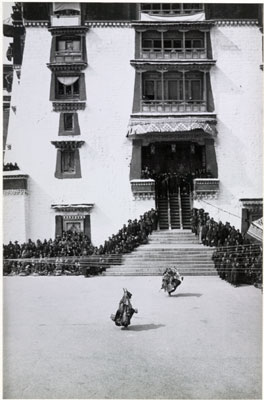
BMR.86.1.51.1 (Album Print black & white)


BMR.86.1.51.1 (Album Print black & white)

Frederick Spencer Chapman
Hugh E. Richardson
February 10th 1937
Lhasa > Potala > Deyang shar
BMR.86.1.51.1
Dancing
Print gelatin silver
British Diplomatic Mission to Lhasa 1936-37
Donated to the British Museum in 1986 by Hugh E. Richardson
B.14 [view film roll]
F. S. Chapman Collection in the Pitt Rivers Museum
1998.131.613
Notes on print/mount - This contact print has been made using Velox printing out paper and the trade name in an oval can be seen on the back of the print. The batch development number '640' has been printed on the back in red ink. [MS 04/04/2006]
Manual Catalogues - Caption in Chapman's hand-written list of negatives made whilst on the Mission to Lhasa, 1936-7 [See PRM Manuscripts Collection]: '1/2 vert. facade and two dancers ’; PRM Manuscripts Collection: ‘List of Tibetan Prints and Negatives’ - Book 3: ‘8/1 - Pair of dancers ’ [MS 06/04/2006]
Other Information - Related Images: Images prefixed with 'B' comprise a group of negatives containing images of Jigme and the Tsarong family, dancers and monks taken on February 10th and 14th 1937 [MS 04/04/2006]
Other Information - Description: "Then, after a further blast on the trumpets Hashang, the Chinese priest-God of happiness, a huge figure with a monstrous smiling mask, strides slowly down the steps into the court attended by six supporters. ... They march slowly, arm in arm across the dancing space, turn round and bow deeply to the Regent then turn again and march to a large chair where Hashang is seated motionless during the whole performance. More blasts of the the trumpets and the curtains, embroidered with dragons in red and gold, part again. Two dancers in demon masks run down the steps, scatter rice from bowls held by monk attendants, and, entering the courtyard, begin their dance. It consists of slow turns and pirouettes with arms outstretched and gesticulating in time with the ponderous rhythm of trumpets, drums and cymbals. Soon they turn and hurry back up the staircase to be succeeded in turn by about eight more pairs of grotesquely masked dancers, some with stags' heads, some with bulls' heads, but the majority in fierce, grinning masks of scarlet gold and green displaying rows of fangs and crowned with skulls. When the last of these pairs has retired the crowd suddenly begins to whistle. This is the traditional reception for the skeleton dance" ['Lhasa Mission, 1936: Diary of Events', Part XIV p.2 , written by Richardson] [MS 06/04/2006]
Other Information - Setting: The “Tse Gutor” masked dances being performed by monks in the eastern courtyard of the Potala. This ceremony takes place at the end of the Tibetan calendar and is designed to purge the sins of the past year. At the Potala it is performed by the monks of Namgye Tratsang who undergo training for many years. Richardson gives a detailed account of this event in “Ceremonies of the Lhasa Year”: “The chief is the Chinese priest Hashang, a huge heavily padded figure in a scarlet robe and with a massive, smiling bald-headed mask. With him are two tiny child-like figures, two more in the dress of Indian sadhus, and two with death’s head masks” (1993:116 – 123) Then two more masked dancers arrive - one representing Shinje the lord of the dead and protector of the Buddhist faith and the other, the stag-headed Tsamuntri. Other dancers portray wrathful protector deities such as Dorje Jigje (with a bull’s head), Tamdrin (the horse-headed), a red masked Mahakala and the black-faced Lhamo. [CH 2003]
Other Information - Location: This photograph seems to have been taken from the balcony directly above the entrance to the eastern courtyard. The Mission had been offered use of the balcony above this one but, as this was better for photographic purposes, Gould apparently allowed the Chinese delegation to use the higher level. Chapman and Doctor Morgan were in charge of photography on this occasion and Chapman comments that he set up seven cameras (presumably a combination of cine and still) to record the proceedings [see ['Lhasa: The Holy City', F. Spencer Chapman, London: Chatto & Windus, 1938, p. 301] [MS 06/04/2006]
For Citation use:
The Tibet Album.
"Masked dancers at Tse Gutor"
05 Dec. 2006. The British Museum.
<http://tibet.prm.ox.ac.uk/photo_BMR.86.1.51.1.html>.
For more information about photographic usage or to order prints, please visit the The British Museum.
© The British Museum